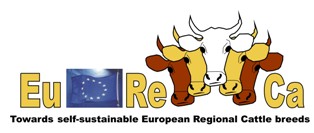Alistana-Sanabresa breed
 |
|
Breed description
Females adult: 131-142 cm height; average adult body weight 500-535 kg.; chestnut coat getting darker towards the front part of the animal.Males adult: 145-155 cm height; average adult body weight 650-900 kg.; chestnut coat with the same pattern as females but darker in males.
Productive rates:
| Males | Females | |
|---|---|---|
| Birth weight (kg) | 33 | 30 |
| Weight at weaning (kg) (extrapolated to 210 days) |
206 | 189 |
| Weight at 14 months (kg) | 437 | |
| Conversion Index at fatten | 5.8 |
Data are based on productive evaluations implemented in 2007 by the
"Estación de Control y Rendimientos de la Junta de Castilla y León" (Control and Performance Station), located in Boñar, León.
Although productive levels are lower than mainstream breed (Charolais), the adaptation
of Alistana-Sanabresa animals to local conditions is far higher. This adaptation is
materialized in the hardiness of this breed; it has less sanitary problems, calving
difficulties and better use of local pastures than mainstream breeds.
History
It is in 1942 when the first technical description of the breed was done. In that date, it was considered a variety of the group of breeds called "Morenas del Noroeste" (Northwest dark-haired), that today are many different breeds (Alistana-Sanabresa, Vianesa, Frieiresa, Sayaguesa, Limiana…). In fact, in the Spanish Breeds Official Census of 1979, Alistana-Sanabresa was considered two different breeds: Alistana and Sanabresa. Finally, just two years later, in the Autochthonous Spanish Breeds Catalogue, Alistana-Sanabresa appeared as a single breed. Traditionally Alistana-Sanabresa breed had a triple aptitude; it was used as a draught animal for agriculture labours being its meat and milk also consumed. With the industrialization of agriculture, from the '60, its use as a draught animal has been consigned to the oblivion, being nowadays dedicated to beef production.Trend of population
In the middle of the last century the Alistana-Sanabresa breed had an estimated population of 37.000 animals. During the following decades the expansion of industrialized agriculture gradually substituted draught animals by vehicles. The "modern" production systems (intensive farming, foreign high productive breeds…) pushed traditional farms to isolated areas where the Alistana-Sanabresa breed was more adapted and was conserved,In the last decade the breed census seems to be recovering, being nowadays above 2.500 animals. There has also occurred a modest expansion of the distribution area of the breed. Alistana-Sanabresa animals can be found nowadays in most of Zamora and in many others provinces of Castilla y León.

1950, 1981, 1999 & 2002 data are estimations from Yanes García, J.E. (2000), Sanchez Belda
(1984), Gaudioso Lacasa, V.R., et al. (1999) & Sanchez Belda. (2002), respectively. 1982 & 1986 data come from the 1987 Official Statistical Yearbook
of the Ministry of Agriculture. Data from 2003 to 2007 based on the breed association Genealogy Book.
Breeding, conservation and promotion
In the 70's the Ministry of Agriculture through the Censyra (Breed and Selection Center) of Lugo,
began breeding selected males to face the lack of Alistana-Sanabresa stub bulls, loaning the
animals and providing semen doses to breeders and creating a semen bank of the best animals.In 1995, Regional Agriculture Authorities began a subsidies program to support endangered autochthonous cattle breeds. Three years later the Alistana-Sanabresa Pedigree Book was created. In the same year, Agriculture authorities supported the formation of A.E.C.A.S. the breed association, that from that date have coordinated Alistana-Sanabresa farmers for the development and conservation of the breed, organising meetings, courses, promotional activities, performance recording, etc.
The activities implemented from the middle 90's seem to have had positive effect on breed demography since they have coincide with an increase of Alistana-Sanabresa census that hopefully will be maintained in the coming years.
Contact
Breeders Association: Asociación Nacional de Criadores de Ganado Bovino Selecto de Raza Alistana-Sanabresa (A.E.C.A.S). C/ Regimiento de Toledo, 2. 490011, Zamora, Spain. Tel. +34 980 52 06 19. E-mail adress: aecas@ono.com. Web site: www.aecas.net.
Bibliography
- Gaudioso Lacasa, V.R., et al. (1999). Razas Autóctonas de Castilla y León. Consejeria de Agricultura y Ganaderia de la Junta de Castilla y León.
- Sanchez Belda (1984). Razas Bovinas Españolas. MAPA
- Sanchez Belda. (2002). Razas Ganaderas Españolas Bovinas. Feagas, MAPA.
- Yanes García, J.E. (2000).Catálogo de razas autóctonas de Castilla y León y región norte de Portugal. Salamanca: Fundación Rei Afonso Henriques.


